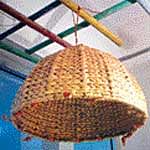
Otherwise a craftsman specializing in making beautiful products out of Kaona of the famous water reed from Manipur, Singh is now an expert in crafting some unbelievably beautiful products out of the dried stem of –- believe it or not –- water hyacinth.
Otherwise considered a weed that suffocates water bodies the world over, water hyacinth (biological name Eichhornia Crassipes), said to have been “introduced” in India in early 20th century by a British Memsahib who got enamoured with the beauty of its colourful flowers in Africa. This weed has suddenly emerged as a source for handicrafts as diverse as mats, mattresses, lampshades, baskets and even furniture, opening up an avenue to showcase the expertise of craftsmen in Northeastern India, like Bhogol from Manipur and Dipti Saikia, Rita Das, Gita Amiya
Adhikari, Rahul Das and Nilim Bhuyan in Assam.
Charging Rs 15-20 per kg
Such has been the initial response to products made of water hyacinth that people who earlier used to give them away for free to anyone willing to take them and thus clean water bodies owned by them, are now charging as much as Rs 15-20 per kg of the plant. And the plant is now being sold in Manipur, where it does not grow as much, by people from Assam. This is the first time that water hyacinth is being used as a source material for handicrafts; but India is definitely a late starter unlike South-East Asian nations, from Myanmar to Malayasia, that have tapped this resource much earlier and captured a large chunk of the global handicraft market.
In a better-late-than-never initiative, the North Eastern Development Finance Corporation Ltd (NEDFi), the Northeast arm of the Ministry for Development of the region, has taken the task to mentorg and train craftsmen in to make handicrafts from water hyacinth. And a key role in this entire initiative is being played by Industry Craft, a Bangalore-based organisation that has trained both trainers and craftsmen in the North-East on how to process water hyacinth suitable for craftwork.
Says Bhogol, “The response I got at the fair from importers has been amazing. Everybody is impressed by the strength of the material and the beauty of the products. I have got trade inquiries from so many countries already.” Though they look docile, dried and processed water hyacinth stalks, which acts as the raw material for all this, are so strong that ropes made of it are used to tie up elephants in Thailand. Thai water hyacinth is also the best variety for such crafts since its stems are usually much longer than its Indian cousin.
The idea that Pani Meteka, as water hyacinth, a menace in the region, is known in Assamese, could be used to start a virtual new movement in the already rich northeastern handicraft artscape happened after NEDFi officials saw furniture made out from it at an international fair in Bangkok.
In fact, P K Saikia, general manager, NEDFi, is so enamoured with the whole idea that he has personally begun motivating people to process water hyacinth. He even occasionally visits interior areas of Assam to hunt of better quality water hyacinth.
Says Manoj Das, NEDFi’s deputy general manager stationed in New Delhi, “After we assessed the potential of water hyacinth as a raw material for handicraft, we got Industry Craft of Bangalore on board, and experts from there visited our R&D centre at Khetri near Guwahati to train 21 people who would serve as trainers to craftsmen in various parts of the region, apart from 10 master craftsmen, on the drying process and treatment of water hyacinth for craftwork. We have till now trained around 100 artisans through a tie up with the DRDAs in five districts in Assam alone. And since these people were already experts in bamboo, cane and ‘sheetal paati’ crafts, it did not take much time for them to adapt to water hyacinth.”
Bags, mats, basketry
After successfully coming out with products like bags, mats, basketry and stationary items, the craftsmen are now going to the next level, by taking up the task of making furniture out of water hyacinth.
“I have just made one ‘Morha’ (round traditional stool) from water hyacinth, and though it costs Rs 1,200 because of the intricate artwork involved, there have been several inquiries about it at the fair,” says Bhogol.
According to Das, right now experiments are going on whether or not natural dyes can be used effectively to make the water hyacinth products look even more attractive.
“The response to these products has been huge, with buyers from Spain, the UK, France, Italy and the US particularly showing keen interest in importing them. But our products will have to compete with the already entrenched industries in South East Asia and China,” says Ashief Ahmed, marketing manager, NEDFi, who is completely focusing on water hyacinth product marketing. “The scope of water hyacinth is huge, as it can be used to make even garment, fibre and paper. We will work towards these targets sooner than latter,” says Das. Water Hyacinth once considered a bane now proves to be a boon.